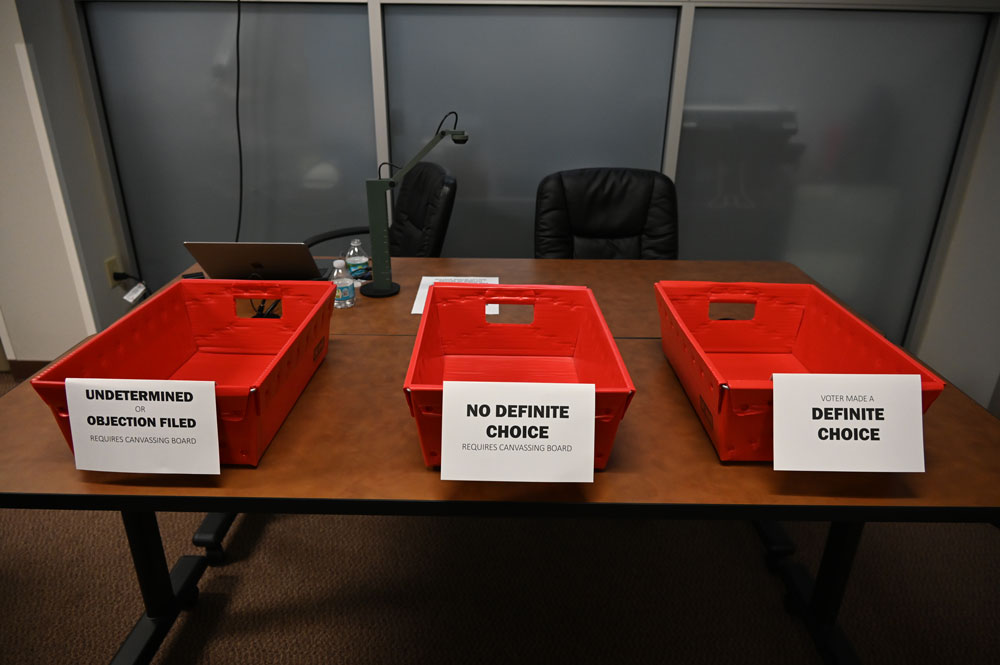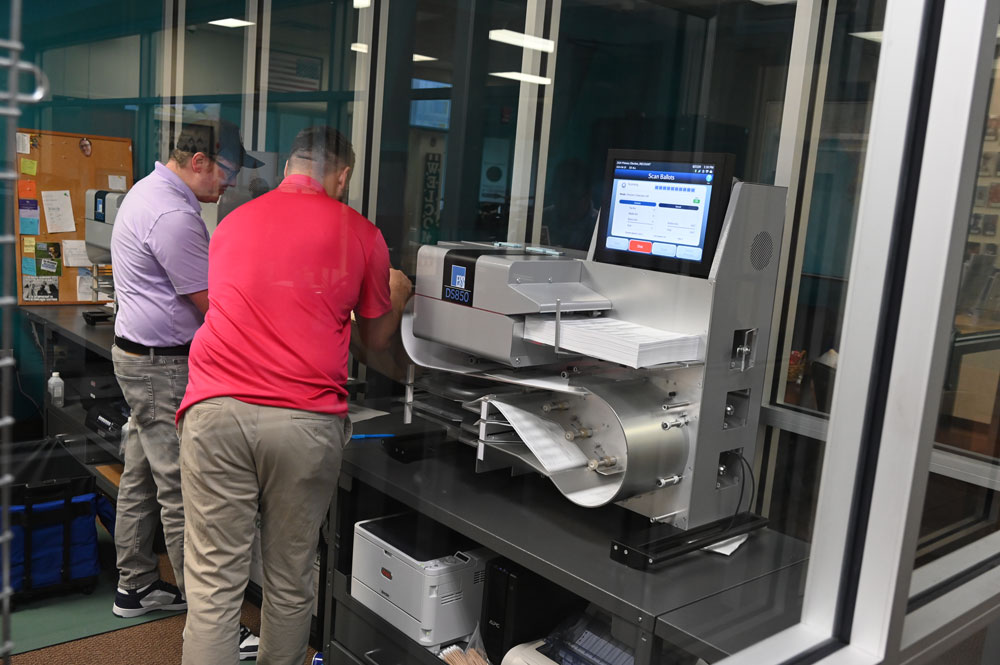
Last Updated: 6:30 a.m. Saturday
A bleary-eyed Flagler County Canvassing Board recessed the recount in a Palm Coast City Council race and a County Commission race a few minutes before 1 a.m. Saturday, only to resume it eight hours later, at 9, as the recount took significantly longer than expected and a hiccup further delayed it.
County Judge Andrea Totten recessed the meeting at 12:56 a.m. The machine recount of every ballot started after 2 p.m. Approaching 7 p.m., it was only 60 percent done. Nearing 9 p.m., the Canvassing Board agreed to adjourn but only once the machine recount was entirely completed, thinking it would take perhaps another 90 minutes. It took nearly another four.
The board reconvenes Saturday morning to conduct the last phase of the recount: a manual recount of so-called over-votes and under-votes.
That will amount to 891 undervotes and five overvotes in the race between Pam Richardson and Ed Danko for County Commission, which Richardson won by 37 votes, and 1,891 undervotes and one overvote in the race between Dana Stancel and Ray Stevens, for the Palm Coast City Council, which Stevens is leading by one vote. Stancel and Stevens are vying for a spot in the November runoff against Andrew Werner.
Stevens’s lead had been two votes, but the last machine recount’s result reduced that to one, for a reason yet undetermined: Supervisor of Elections Kaiti Lenhart attributes the discrepancy to a likely undervote that was not detected in a previous count.
Undervotes are when a voter leaves a race oval’s blank. In rare cases, the voter may have made an errant mark or circled a name, which the scanner would not have picked up. Those ballots will be examined by the Canvassing Board. Overvotes are when a voter marks more than one oval, or marks them oddly, unclearly, requiring the Canvassing Board to determine whether the vote is valid or not.
The board will not examine every single ballot. Three Supervisor of Elections staffers will sort the over-votes and under-votes into three bins, with obvious undervotes–ballots with no mark at all–placed in a separate bin that will not be examined, while questionable ballots that need the board’s determination are placed in one of two other bins. The overwhelming majority of ballots will end up in the bin that does not require review.
That sorting done, the board starts its portion of the manual recount–in essence, the hanging chad portion, as many people still familiar with the 2000 recount of the Bush-Gore presidential race may remember it. At the time, improperly punched punch-cards in some of Florida’s counties, like Broward, created hanging chads rather than clear holes next to a candidate’s name, requiring canvassing board members to determine the voter’s intent. There are no punch cards in Flagler, but the idea is the same: when the voter’s intent with a pen is not clear, the board attempts to make the determination.

The machine recount was not expected to change the result announced on election night, and did not. Friday morning’s review of some 40 provisional ballots and problematic mail ballots did not change the outcome, either. It reduced Richardson’s margin by three votes and keept the Stevens-Stancel margin at two, after each of them got three additional votes. (See: “Ballot Review Doesn’t Change Outcome: Richardson Beats Danko, Stevens Holds 2-Vote Lead.”)
The hand recount Saturday of the ballots with questionable marks is also not expected to substantially change the outcome of the Richardson-Dankop race: the statistical possibility of a change is extremely remote, but not impossible. But chances of a change in the Stancel-Stevens race are higher.
The recount started Friday afternoon with nearly three dozen people in the area of the supervisor’s office where the Canvassing Board was meeting. (The Canvassing Board consists of Lenhart, Totten, and County Commissioner Dave Sullivan, with County Commissioner Donald O’Brien as the alternate. O’Brien took over for Sullivan around 8:30 p.m.)
Observers, officials and candidates passed the time in conversation, in calls home, in reading: the feel was more lounge than office, more social than political, with an absence of tension or tempers despite the occasion: Lenhart’s cheery disposition set the tone.
The longer the recount lasted, the fewer people filled the room, the more humorous the mood. When the Stancels had had enough (Donna had joined her husband, Dana), Lenhart hugged husband and wife before they left. “I really had a great day,” Stancel said to Lenhart. He’d spent most of the day hanging out with Stevens. The two have decided that whoever loses will throw his support behind the other to beat Werner. “We really appreciate the work you guys do,” Stancel said.
Lenhart ordered pizza, played Sammy Hagar and Journey on her phone before the music played on overhead speakers, and for a while led a game of Spades with Richardson and others. After a lull, County Commissioner Leann Pennington appeared, with Kim Carney (the winner of her County Commission race) and others. Pennington said she’d been texting Richardson and getting no response. She got worried. So she decided to drop by.
Much later in the night, there was a surprise visit by a person associated with the campaign of Derek Barrs, the school board candidate who lost his race by less than 300 votes to Janie Ruddy. He sought an explanation from Lenhart of the counting hiccup he must’ve read here.
At one point ballots jammed in the scanner, resulting in a miscount of 300 ballots–not of votes–requiring the entire rescan of all early votes, as the batch had been an early voting batch. The Canvassing Board tested a second scanner and got it going so the job wouldn’t delay the rest of the ongoing count. But it became clear that the machine count would end too late to continue the operation further into the night.
Every once in a while a few damaged ballots would be handed the canvassers to be transferred to cleaner sheets. It happens: ballots with bad toner have to be reproduced. One member of the board would read out the votes, another would fill in the proper ovals, and the ballots would be returned to the scanning machine to be read.
By the time the machine recount ended, the room was empty but for Lenhart, Totten, O’Brien, a bailiff and the few remaining staffers who had fed the ballots into the machines form about 100 boxes, after they’d been on their feet all day. They got applause the moment one of them stepped out and handed tally sheets to Lenhart. The odd discrepancies as Lenhart and Totten compared the first count to the last itself felt like a chad hung over the night’s final hour, now turned morning.





























Leave a Reply